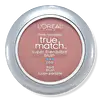What's inside
What's inside
 Key Ingredients
Key Ingredients

 Benefits
Benefits

No benefits
 Concerns
Concerns

 Ingredients Side-by-side
Ingredients Side-by-side

Talc
AbrasiveDimethicone
EmollientNylon-12
Polymethylsilsesquioxane
Cetyl Dimethicone
EmollientMagnesium Stearate
Cosmetic ColorantTrimethylsiloxysilicate
EmollientPhenoxyethanol
PreservativeMethylparaben
PreservativeSilica
AbrasiveEthylparaben
PreservativePropylparaben
PreservativeIsobutylparaben
AntimicrobialButylparaben
MaskingMica
Cosmetic ColorantCI 77891
Cosmetic ColorantCI 77491
Cosmetic ColorantCI 77492
Cosmetic ColorantCI 77499
Cosmetic ColorantCI 75470
Cosmetic ColorantCI 73360
Cosmetic ColorantCI 77007
Cosmetic ColorantTalc
AbrasiveMagnesium Myristate
Silica
AbrasiveCalcium Aluminum Borosilicate
Dimethicone
EmollientCaprylic/Capric Triglyceride
MaskingLauroyl Lysine
Skin ConditioningSimmondsia Chinensis Seed Oil
EmollientSynthetic Fluorphlogopite
Diethylhexyl Syringylidenemalonate
Skin ProtectingTrimethylsiloxysilicate
EmollientPhenoxyethanol
PreservativeChlorphenesin
AntimicrobialOctyldodecanol
EmollientButylene/Ethylene Copolymer
Talc, Magnesium Myristate, Silica, Calcium Aluminum Borosilicate, Dimethicone, Caprylic/Capric Triglyceride, Lauroyl Lysine, Simmondsia Chinensis Seed Oil, Synthetic Fluorphlogopite, Diethylhexyl Syringylidenemalonate, Trimethylsiloxysilicate, Phenoxyethanol, Chlorphenesin, Octyldodecanol, Butylene/Ethylene Copolymer
Ingredients Explained
These ingredients are found in both products.
Ingredients higher up in an ingredient list are typically present in a larger amount.
Dimethicone is a type of synthetic silicone created from natural materials such as quartz.
What it does:
Dimethicone comes in different viscosities:
Depending on the viscosity, dimethicone has different properties.
Ingredients lists don't always show which type is used, so we recommend reaching out to the brand if you have questions about the viscosity.
This ingredient is unlikely to cause irritation because it does not get absorbed into skin. However, people with silicone allergies should be careful about using this ingredient.
Note: Dimethicone may contribute to pilling. This is because it is not oil or water soluble, so pilling may occur when layered with products. When mixed with heavy oils in a formula, the outcome is also quite greasy.
Learn more about DimethiconePhenoxyethanol is a preservative that has germicide, antimicrobial, and aromatic properties. Studies show that phenoxyethanol can prevent microbial growth. By itself, it has a scent that is similar to that of a rose.
It's often used in formulations along with Caprylyl Glycol to preserve the shelf life of products.
Silica, also known as silicon dioxide, is a naturally occurring mineral. It is used as a fine, spherical, and porous powder in cosmetics.
Though it has exfoliant properties, the function of silica varies depending on the product.
The unique structure of silica enhances the spreadability and adds smoothness, making it a great texture enhancer.
It is also used as an active carrier, emulsifier, and mattifier due to its ability to absorb excess oil.
In some products, tiny microneedles called spicules are made from silica or hydrolyzed sponge. When you rub them in, they lightly polish away dead skin layers and enhance the penetration of active ingredients.
Learn more about SilicaTalc is a clay mineral. It helps absorb moisture and improve the texture of products. Like other types of clay, Talc can have a slight exfoliating effect on skin. Talc can be added to increase the volume of products.
Some Baby powders are made by combining talc with corn starch. The word "talc" comes from Latin and originates from Arabic. Talc is a mineral commonly found throughout the world.
If you have any concerns about using talc, we recommend checking out the FDA's official page.
Learn more about TalcThis silicone is an emollient. Emollients create a thin film on the skin to prevent moisture from escaping.
It is not soluble in water and helps increase water-resistance in products.
According to a manufacturer, it can blend seamlessly with silicone oils, such as Cyclopentasiloxane.
Learn more about Trimethylsiloxysilicate